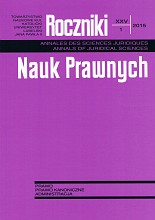Rozumowanie per analogiam w prawie precedensowym: dwa ujęcia analogii
Analogical reasoning in precedential law: Two accounts of analogy
Author(s): Maciej KoszowskiSubject(s): Law, Constitution, Jurisprudence
Published by: Towarzystwo Naukowe KUL & Katolicki Uniwersytet Lubelski Jana Pawła II
Keywords: analogy; analogical; reason; reasoning; inference; from; similarity; argument; a simile; model; theory; account; judicial; precedent; precedential; applying; law; intuition; intuitive; rational; reason; principle; rule; proportion; based; oriented
Summary/Abstract: Apart for the concise presentation of the rule-based model of binding judicial precedent, this article describes two basic accounts of analogical reasoning in precedential law. The first account has been named: the factual model and the second: the rational model. This terminology was adopted due to the fact that judgment of similarity within the factual model is deemed to be a direct result of the very facts of the cases being compared, or of the unfathomed mystical workings of human intuition (emotions) or the outcome desired for the case at hand. The rational model, in turn, is based upon the notion of precedential reasons and casual facts, which are the facts that are relevant in the light of such reasons. Dependence upon these two notions makes the rational model more predictable and explicable. In certain circumstances, however, analogy to proceeds needs therein some additional factors which do not stem from the gist of that model. The factual model, unpredictable though it may seem to be, is faster and apt to provide us with just, or socially desirable, conclusions, especially when utilized by a person of a great legal knowledge and experience. Two other possible accounts of analogical reasoning in precedential law, i.e. the principle-based model and the proportional model, have been rebutted. The reason is: lack of analogical pattern of thinking involved and serious difficulties in its forensic application respectively.
Journal: Roczniki Nauk Prawnych
- Issue Year: 25/2015
- Issue No: 1
- Page Range: 7-41
- Page Count: 35

